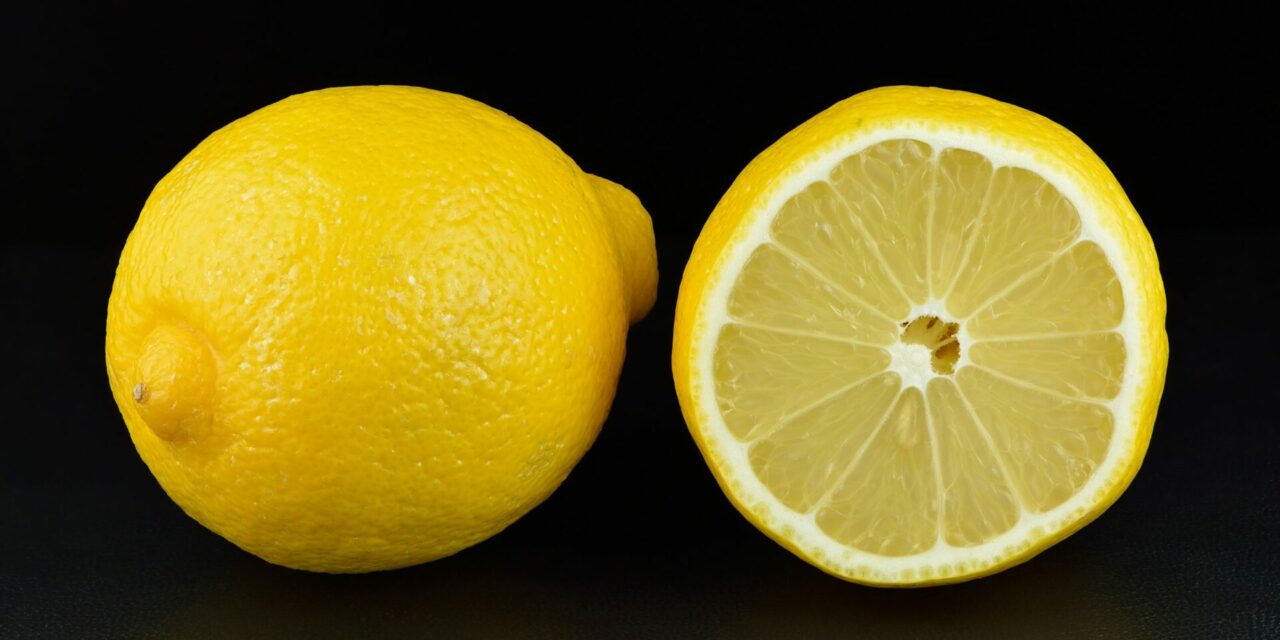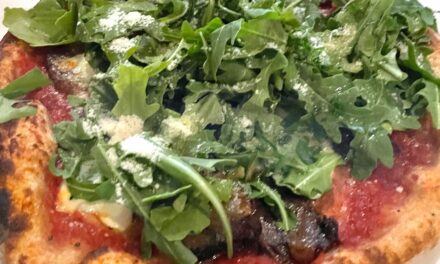Lemon, Whole and Split, by Ivar Leidus, CC BY-SA 4.0 via Wikimedia Commons
Remember the Lemon
The pronkstilleven showpieces were the ooh la las of the Dutch still life paintings.
Loosely translated as “Ostentatious Still Life,” the pronkstilleven featured the same everyday foodstuffs and objects as their leaner predecessors, only on a grand scale. These complex, elaborate compositions were overflowing cornucopias of grapes, lemons, game, watches, silver, wine, and occasionally, monkeys.
Still Life paintings remain popular five centuries past their golden age, when somewhere around a quarter million artworks were created. We marvel still at the impossible realism of jumbled sundries, the strange spell of those dark and ancient heavily curtained rooms with fruit and flowers piled on every table. How did these artists, who worked by day-light or candle-light, and painstakingly by their own hand scraped pigment from mineral blocks to mix in oils, make impossibly metallic bronze and transparent, brittle glass?
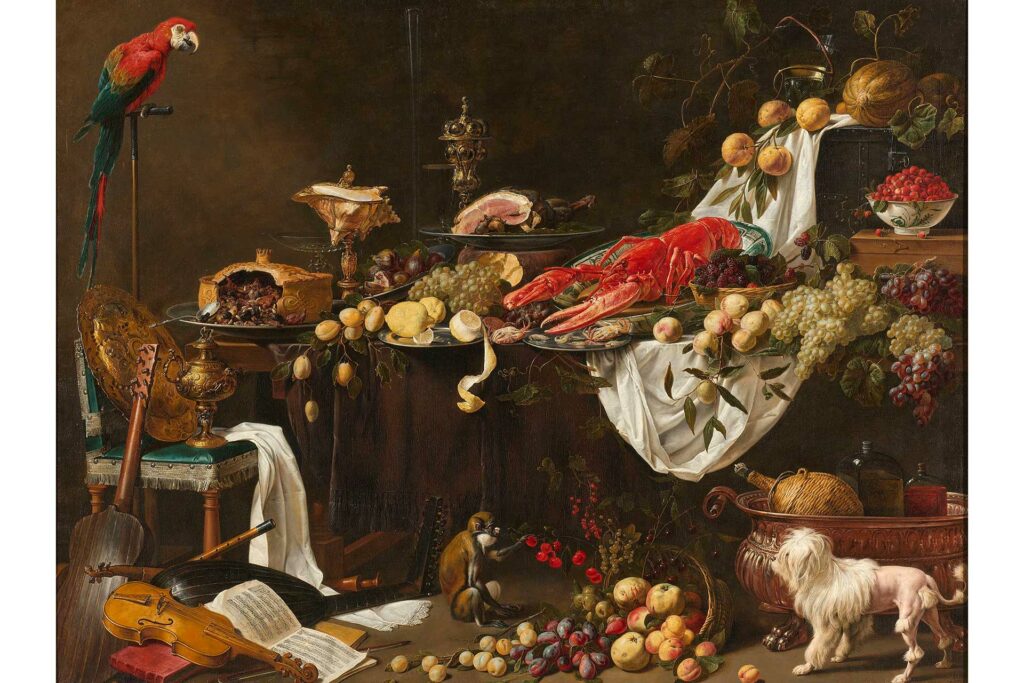
Still Life Banquet, by Adriaen van Utrecht (Netherlands) 1644
This was one of the main points, of course. Following the Reformation, artists and art were no longer solely patronized by church and state. Still life paintings were all the rage because everyday people- everyday rich people, that is- could buy them and show off their good taste. The artists used their subjects to show off their finest skills in hopes of further commissions- just how thin could they get that rind of lemon?
People were enjoying artwork for the first time that reflected daily life rather than classical mythology and overt Biblical themes. They wanted paintings that showed off their status as wealthy, educated, travelling merchants. The pronkstilleven were ridiculous still-life, overflowing with abundance.
But the Netherlands and the era were still religious, even as the church and state were separating with the spread of Protestantism. And the still-life paintings were still religious, too, even if they appeared secular and often, showy. Still-life paintings had double meanings, warnings about the fleeting transience of wealth and earthly pursuits. They were memento mori- reminders that rich or poor, hungry or well fed- we are all going to die. Each bowl of blessings was a divine gift, and gratitude and humility were in order. The ticking pocket watches, the fragile glasses and thin bone china, and the fruits, shiny today and rotten tomorrow, were all spiritual reminders.
In Adriaen van Utrecht’s sumptuous banquet, the artist impresses with his skill at tint and texture. Look how he can make life-like the peel of an apple, the fine fur of animals, the light on bronze and glassware, the rattan of woven bottle holders, the folds in a tablecloth. The painting also celebrates the world beyond the lowlands: the parrot, the monkey, imported fruits. It celebrates culture and education and wealth.
But right there in the middle, dangling down above the curious monkey and his cherry toys, is the real meaning of all it- a lemon unravelling.
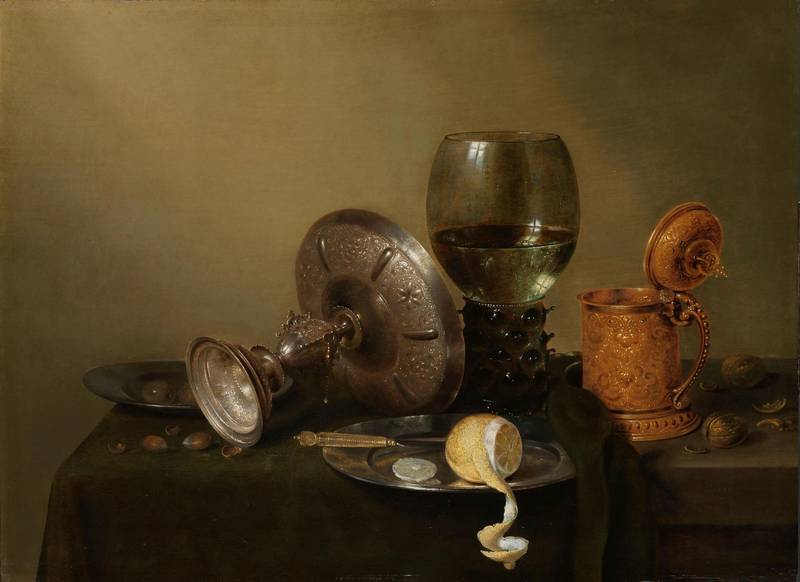
Still Life with a Gilded Beer Tankard, by Willem Claesz (Netherlands) 1634
Lemons from the Mediterranean were in transition at the time from rare luxury to essential culinary comestible. Well to do Dutch imported lemon trees in pots and grew them for their homes and kitchens. De Verstandige Kok, or The Sensible Cook, a cookbook published in 1669, already contained numerous recipes with lemons.
Lemons were also beloved and valued in Spain and Italy, where they were staples, and anywhere else that they reached for their culinary and medicinal gifts. Everyone loved a squeeze of lemon juice when they could get it. Especially the artists- at least half of all known still-life paintings feature lemons. Lemons allowed a bright yellow contrast to the darkness of the genre, and their curling rinds were a chance to show off painterly prowess. But most important of all was the symbolism. Lemons were traditionally associated with the Virgin Mary, emblems of fidelity and purity. The Protestants also appreciated the contrast between their cheerful beauty and how fast it could fade to rot, an important memento mori of temporality. The fruit dazzled in dishes and helped freshen foods and palates, yet without honey or other contrasting flavours, it was disappointing to consume on its own.
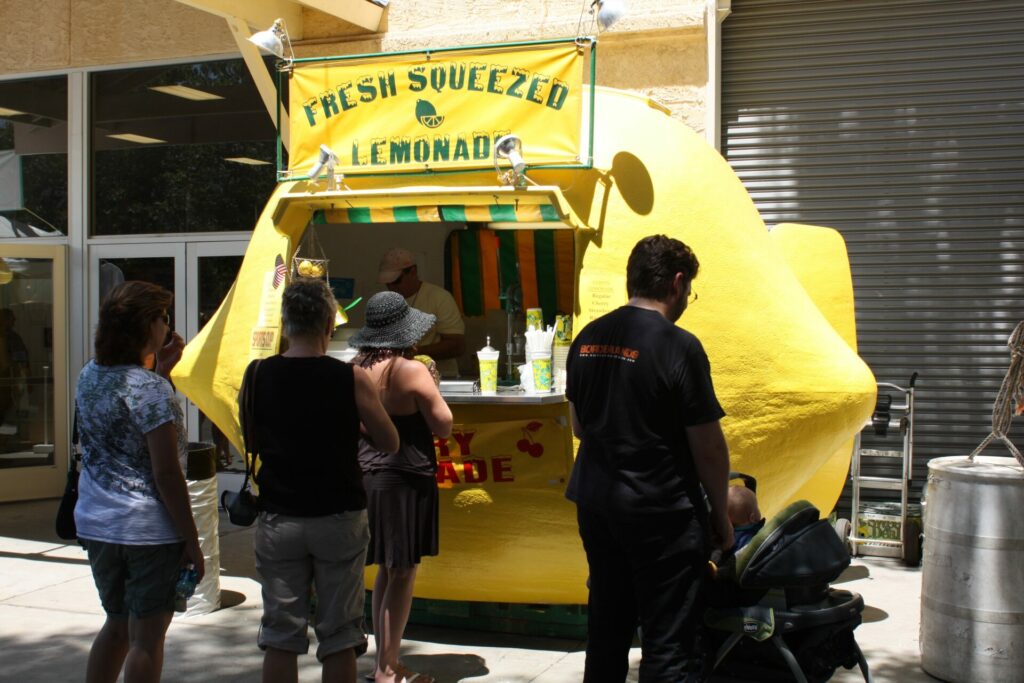
Cute Lemonade Stand, by Naotake Murayama via Flickr (CC BY-NC-ND 2.0)
The whole deal was a kind of reverse way of approaching the famous saying, “When life gives you lemons, make lemonade.” (The actual phrase, in a eulogy for a disabled actor, was “He picked up the lemons that Fate had sent him and started a lemonade-stand.” The speech was by Elbert Hubbart, who also, incidentally, coined the phrase, “Jesus was an anarchist.”)
It was a way of urging you to remember the lemon- the sour, bitter, disappointing essence behind the sweet fragrance and sunshiny rind.
Remember the lemon, indeed.
“Lemon” is of course also a widespread slur for cars that suck, a term from a clever Volkswagen ad in 1960 that spread from vehicles to describe anything that is a dud.
The thing is, from the positivity movement to the used car lot to the deepest spiritual messages in Dutch art history, the analogy itself is a bit of a lemon.
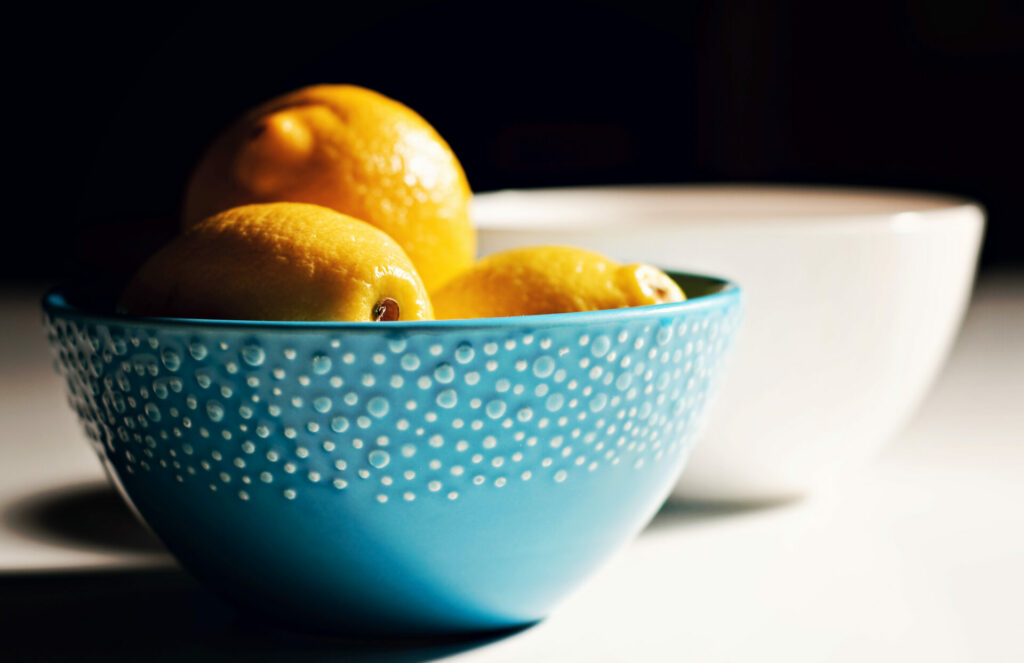
Lemons, by Lisa Sabater-Mozo, via Flickr (CC BY-NC-ND 2.0)
The famous yellow fruit may not be the sweetest citrus on the block, but it is deeply revered and prized in food, decoration, and medicine across cultures for millennia. When you want to banish disease, when you want the most beautiful garden, when you want the most wonderful perfume, when you want to perfect your linguine, your lobster, your fish, your soup, your cheese, your pie, your pound cake, remember the lemon.
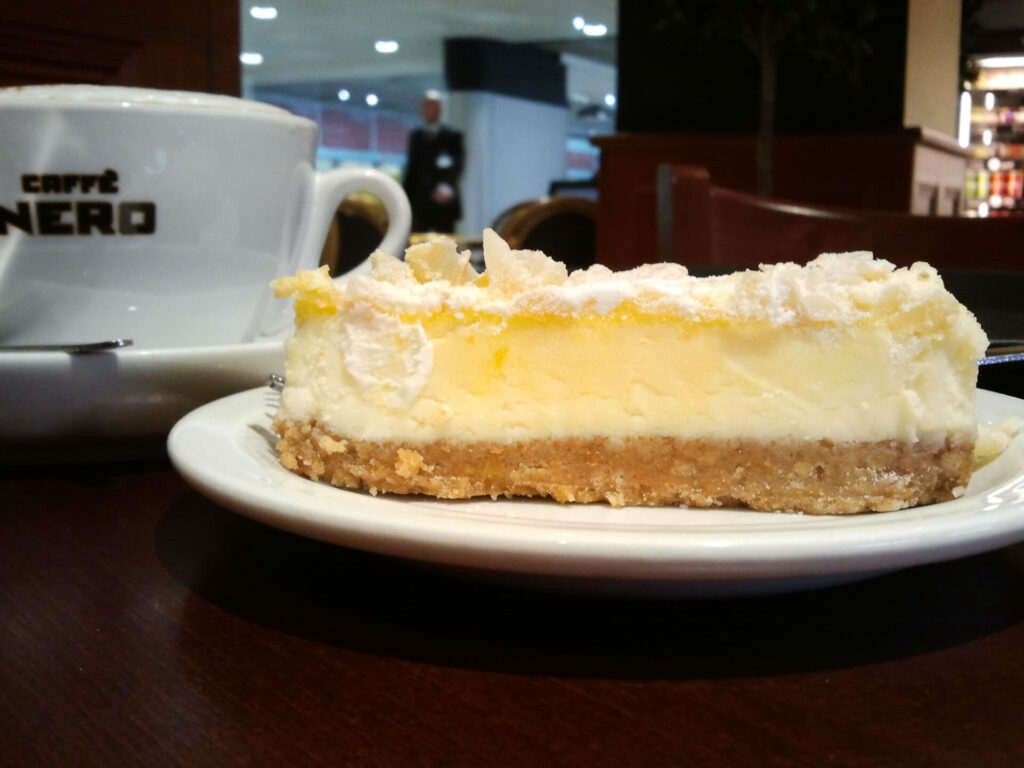
Lemon Cheesecake by Eltpics via Flickr (CC BY-NC-ND 2.0)
The lemon is among the most beloved of foods anywhere, bar none. Countless cuisines and refreshing beverages are utterly dependent on them.
From the sweet bursting scent of their zest to the clean, acerbic splash of their juice, lemons are bright and clean on the palate. The presence of lemon juice is the definition of freshness. A squeeze of lemon is all you need to balance just about anything in the kitchen. Lemon takes humdrum to the next level.
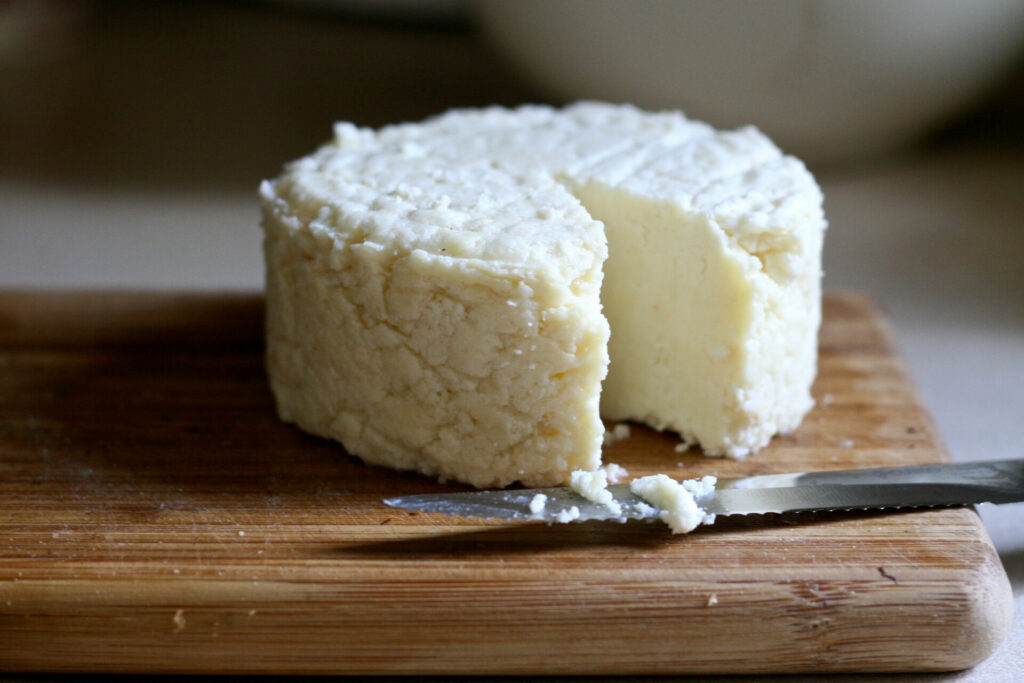
Pressed Lemon Cheese, by Chiot’s Run via Flickr (CC BY-NC-ND 2.0)
It is perfect in simplicity, taking the spotlight or supporting role with equal aplomb. The best possible flavour for seafood is nothing but lemon, butter and salt. Avgolemono, a sauce and soup staple in the Mediterranean, is just lemon, eggs, and chicken or fish broth (or sheep head broth, if you happen to have a leftover lamb carcass on hand.) When there’s nothing else available, lemon alone will shine. When there’s something missing, lemon will make it complete.
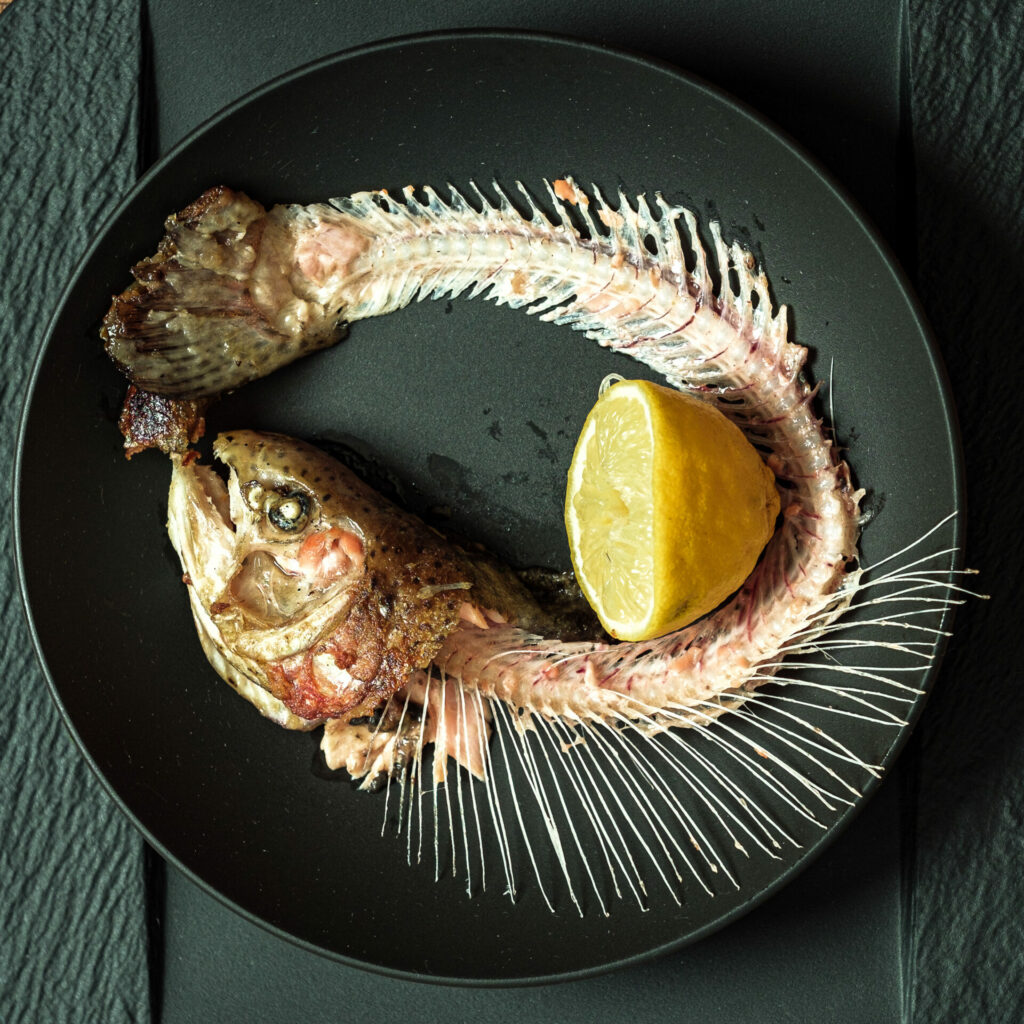
After Dinner, Salmon Trout with Lemon, by Traveller_40 via Flickr (CC BY-NC-ND 2.0)
Lemon works exquisitely with sweet. And lemon goes amazingly with savoury. It’s good for breakfast, lunch, dinner, and desert. It’s essential for seafood. It’s imperative for salads. It’s the very best of all the cakes, creams, and custards.
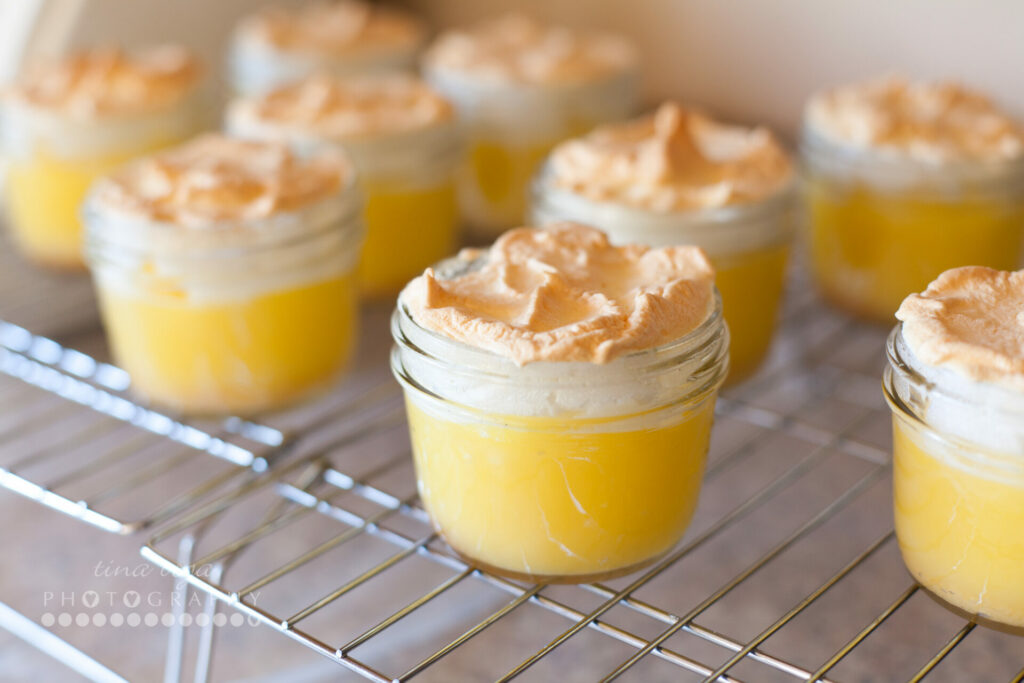
Lemon Merinque Pie, by Tina Vega via Flickr (CC BY-NC-ND 2.0)
The origin story of lemons is shrouded in the mists of history, but sometime around eight million years ago, near the southeast foothills of the Himalayan mountains, this miracle emerged from the earth. Early versions ultimately became oranges, limes, grapefruits, pomelos, and all the citrus stars we adore. The lemon as we know it has been with us for about four million years, according to the journal of record, Nature.
Our love affair with lemons is more recent, but still ancient. Egyptians have been enjoying lemonade for a couple thousand years, and in India for centuries, too. A classic bridal gift to this day is a pitcher with glasses, called a “lemon set.” The sunny yellow fruits were revered in Greece and Italy for at least as long, to go with olive oil and also as medicine. Throughout the Middle East and Near East, in modern Iran, Iraq, Syria, Lebanon, and beyond, lemons had medical and mystical purposes, and were a crown jewel in the ornamental gardens. The juice of lemons cold or in hot tea has been used in numerous cultures for liver health, prevention and treatment of colds, and as an antidote to poison.

Lemon Set, India
Today modern medicine acknowledges the outstanding health benefits of lemons. Lemons have hepatoprotective properties, hence the popular habit of drinking lemon water in the morning. Such gestures can help support against fatty liver and encourage bile production. Lemons are loaded with vitamin C and can help you better absorb iron. They are energizing and cleansing. They have antibacterial properties. Their citric acid helps ward against kidney stones. They are full of antioxidants, with their whole host of protective qualities. And the list goes on.
But for all the support lemons lend to robust health, and for all the ornamental splendour they add to our gardens, where lemons shine brightest is indisputably in the kitchen. World cuisine would be grossly diminished without them. Chefs of all stripes, from famous superstar gourmets to our mothers, all list lemons among their most necessary ingredients.
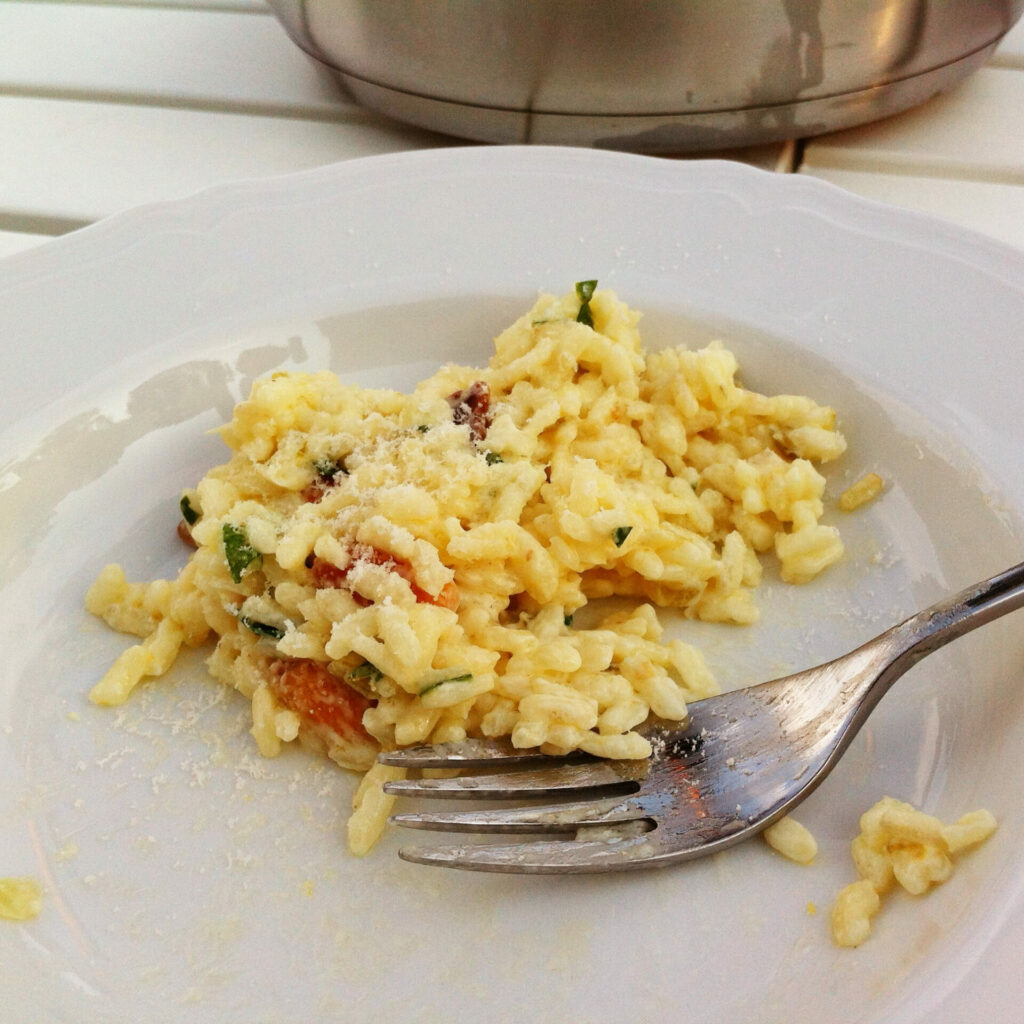
Homemade Mascarpone Almond Lemon Risotto, by Sami Keinanen via Flickr (CC BY-NC-ND 2.0)
Just a few recipes where lemon reigns supreme: grilled scallops with garlic and lemon; black tea with lemon; lemon linguine; lemon meringue pie; risotto with parmesan and lemon; lemon poppyseed muffins; Chinese lemon chicken; orzo and cherry tomatoes with basil, lemon, and olive oil; fish and chips; lemon cream pork chops; lemon chicken soup…
And no one in their right mind would bother with a summer gin and tonic without a giant wedge of lemon, would they?
Remember the lemon- it’s the key to the kitchen. And as our dutiful Protestant artists have been urging us to keep in mind for 500 years, life is short. Too short for cuisine without lemons.
Lorette C. Luzajic
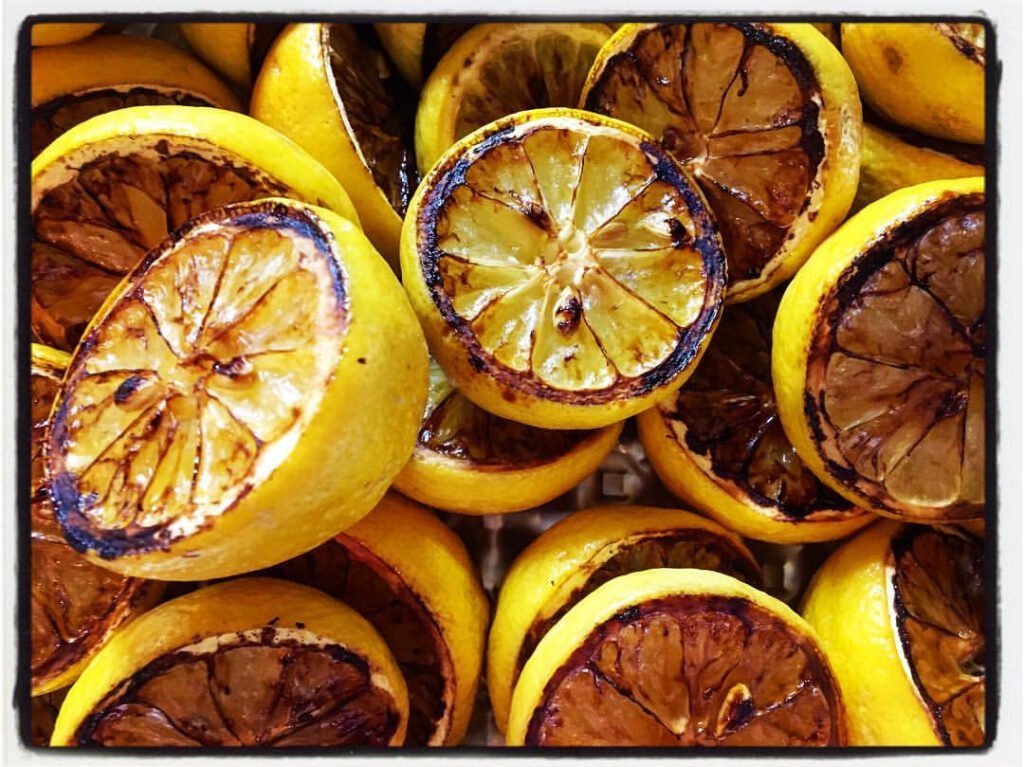
Daniel’s Lemons, by Hallie H.H. via Flickr (CC BY-NC-ND 2.0)

